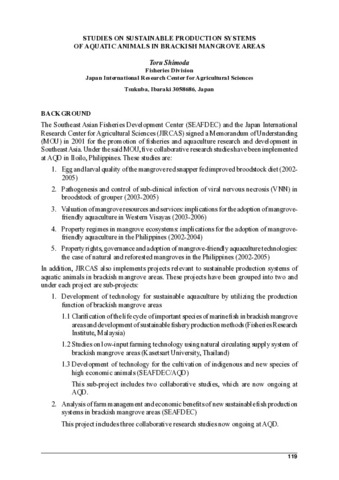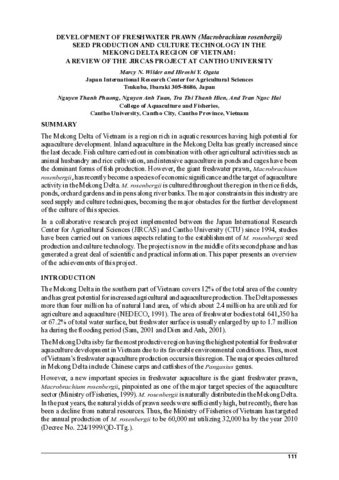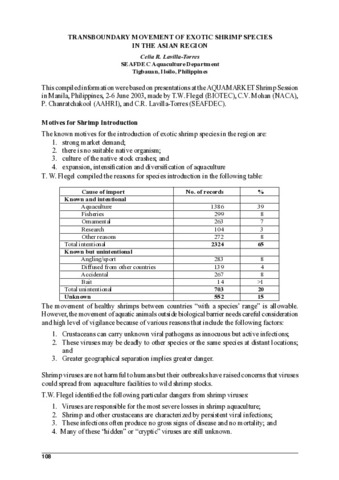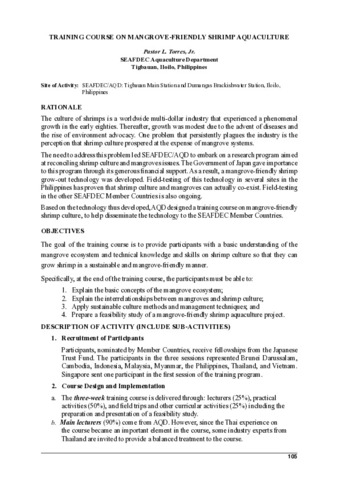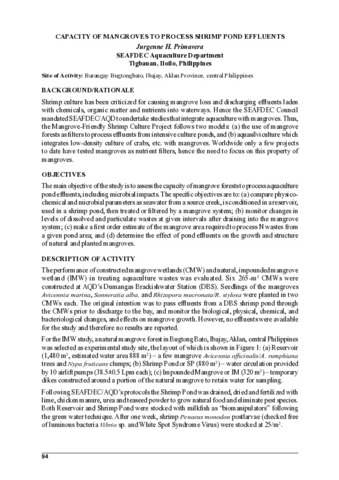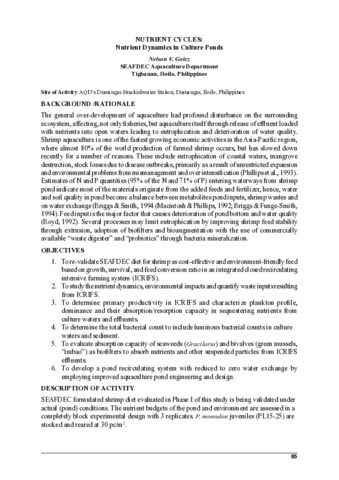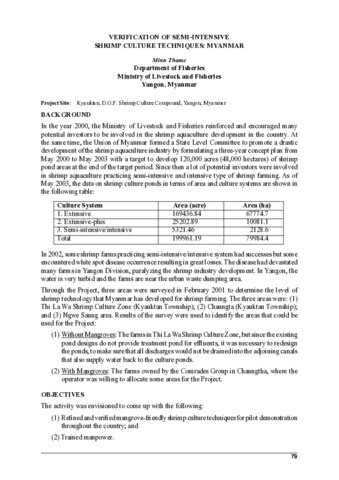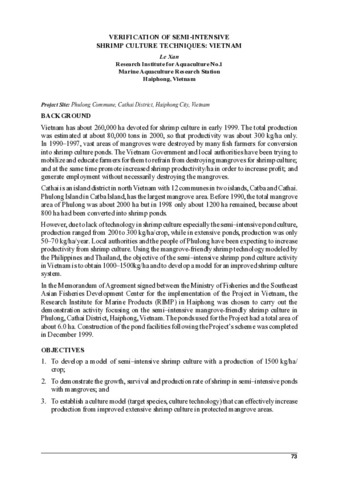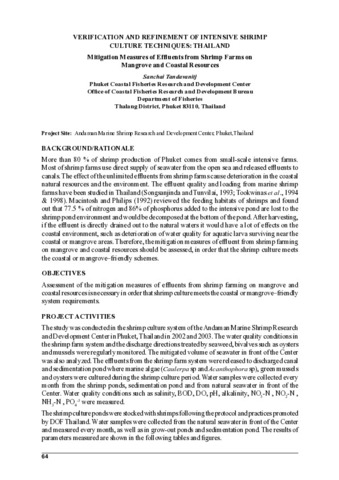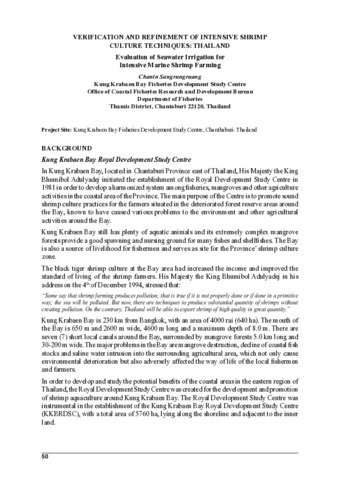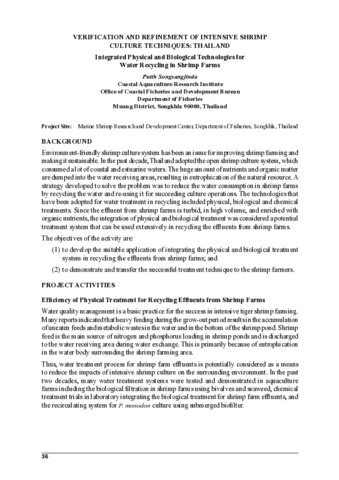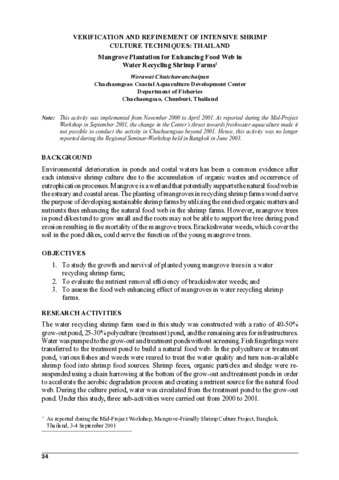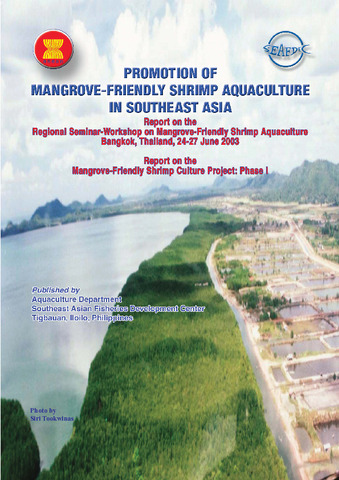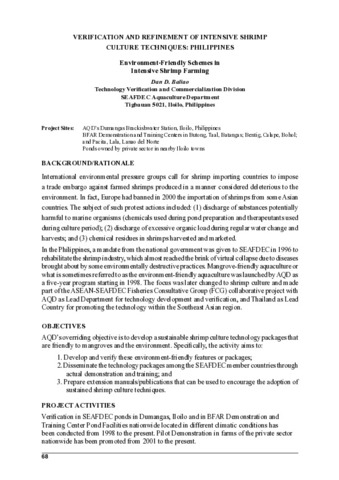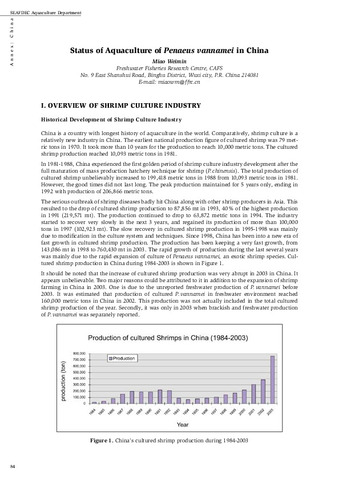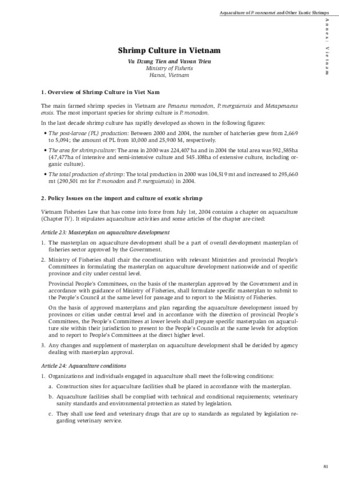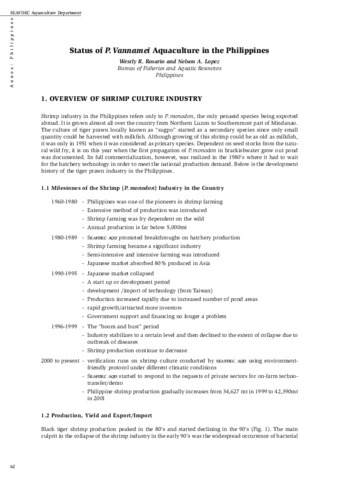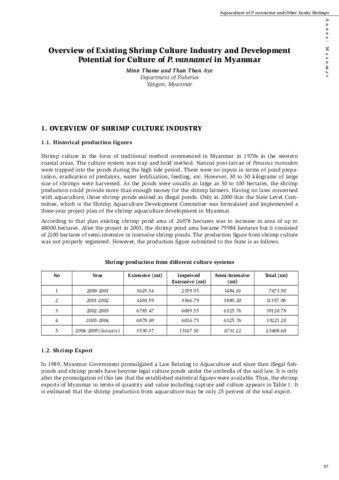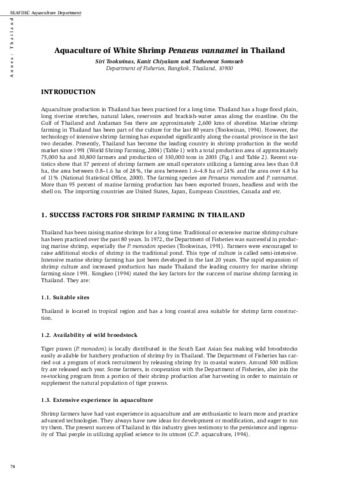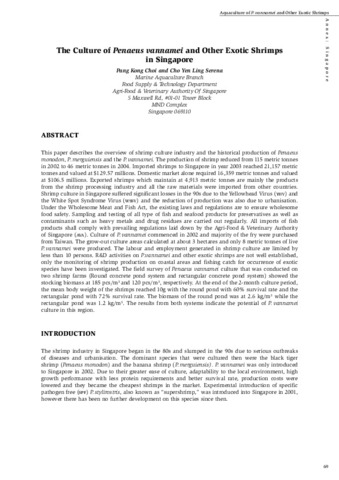Meeting Reports: Recent submissions
Now showing items 41-60 of 111
-
Studies on sustainable production systems of aquatic animals in brackish mangrove areas.
(Aquaculture Department, Southeast Asian Fisheries Development Center, 2004)The Southeast Asian Fisheries Development Center (SEAFDEC) and the Japan International Research Center for Agricultural Sciences (JIRCAS) signed a Memorandum of Understanding (MOU) in 2001 for the promotion of fisheries ... -
Development of freshwater prawn (Macrobrachium rosenbergii) seed production and culture technology in the Mekong Delta Region of Vietnam: A review of the JIRCAS Project at Cantho University.
(Aquaculture Department, Southeast Asian Fisheries Development Center, 2004)The Mekong Delta of Vietnam is a region rich in aquatic resources having high potential for aquaculture development. Inland aquaculture in the Mekong Delta has greatly increased since the last decade. Fish culture carried ... -
Transboundary movement of exotic shrimp species in the Asian region.
(Aquaculture Department, Southeast Asian Fisheries Development Center, 2004)This compiled information were based on presentations at the AQUAMARKET Shrimp Session in Manila, Philippines, 2-6 June 2003, made by T.W. Flegel (BIOTEC), C.V. Mohan (NACA), P. Chanratchakool (AAHRI), and C.R. Lavilla-Torres ... -
Training course on mangrove-friendly shrimp aquaculture.
(Aquaculture Department, Southeast Asian Fisheries Development Center, 2004)The culture of shrimps is a worldwide multi-dollar industry that experienced a phenomenal growth in the early eighties. Thereafter, growth was modest due to the advent of diseases and the rise of environment advocacy. One ... -
Capacity of mangroves to process shrimp pond effluents.
(Aquaculture Department, Southeast Asian Fisheries Development Center, 2004)Shrimp culture has been criticized for causing mangrove loss and discharging effluents laden with chemicals, organic matter and nutrients into waterways. Hence the SEAFDEC Council mandated SEAFDEC/AQD to undertake studies ... -
Nutrient cycles: Nutrient dynamics in culture ponds.
(Aquaculture Department, Southeast Asian Fisheries Development Center, 2004)The general over-development of aquaculture had profound disturbance on the surrounding ecosystem, affecting, not only fisheries, but aquaculture itself through release of effluent loaded with nutrients into open waters ... -
Verification of semi-intensive shrimp culture techniques: Myanmar.
(Aquaculture Department, Southeast Asian Fisheries Development Center, 2004)In the year 2000, the Ministry of Livestock and Fisheries reinforced and encouraged many potential investors to be involved in the shrimp aquaculture development in the country. At the same time, the Union of Myanmar formed ... -
Verification of semi-intensive shrimp culture techniques: Vietnam.
(Aquaculture Department, Southeast Asian Fisheries Development Center, 2004)Vietnam has about 260,000 ha devoted for shrimp culture in early 1999. The total production was estimated at about 80,000 tons in 2000, so that productivity was about 300 kg/ha only. In 1990–1997, vast areas of mangroves ... -
Mitigation measures of effluents from shrimp farms on mangrove and coastal resources.
(Aquaculture Department, Southeast Asian Fisheries Development Center, 2004)More than 80 % of shrimp production of Phuket comes from small-scale intensive farms. Most of shrimp farms use direct supply of seawater from the open sea and released effluents to canals. The effect of the unlimited ... -
Evaluation of seawater irrigation for intensive marine shrimp farming.
(Aquaculture Department, Southeast Asian Fisheries Development Center, 2004)The seawater irrigation system has benefited the intensive marine shrimp culture making shrimp culture sustainable and increasing shrimp production. The results obtained from this research study indicated that the adverse ... -
Integrated physical and biological technologies for water recycling in shrimp farms.
(Aquaculture Department, Southeast Asian Fisheries Development Center, 2004)Environment-friendly shrimp culture system has been an issue for improving shrimp farming and making it sustainable. In the past decade, Thailand adopted the open shrimp culture system, which consumed a lot of coastal and ... -
Mangrove plantation for enhancing food web in water recycling shrimp farms.
(Aquaculture Department, Southeast Asian Fisheries Development Center, 2004)Environmental deterioration in ponds and costal waters has been a common evidence after each intensive shrimp culture due to the accumulation of organic wastes and occurrence of eutrophication processes. Mangrove is a ... -
Promotion of mangrove-friendly shrimp aquaculture in Southeast Asia
(Aquaculture Department, Southeast Asian Fisheries Development Center, 2004)Sulit, Virgilia T. -
Environment-friendly schemes in intensive shrimp farming.
(Aquaculture Department, Southeast Asian Fisheries Development Center, 2004)International environmental pressure groups call for shrimp importing countries to impose a trade embargo against farmed shrimps produced in a manner considered deleterious to the environment. In fact, Europe had banned ... -
Status of aquaculture of Penaeus vannamei in China.
(Aquaculture Department, Southeast Asian Fisheries Development Center, 2005)China is a country with longest history of aquaculture in the world. Comparatively, shrimp culture is a relatively new industry in China. The earliest national production figure of cultured shrimp was 79 metric tons in ... -
Shrimp culture in Vietnam.
(Aquaculture Department, Southeast Asian Fisheries Development Center, 2005) -
Status of P. vannamei aquaculture in the Philippines.
(Aquaculture Department, Southeast Asian Fisheries Development Center, 2005)Shrimp industry in the Philippines refers only to P. monodon, the only penaeid species being exported abroad. It is grown almost all over the country from Northern Luzon to Southernmost part of Mindanao. The culture of ... -
Overview of existing shrimp culture industry and development potential for culture of P. vannamei in Myanmar.
(Aquaculture Department, Southeast Asian Fisheries Development Center, 2005)Shrimp culture in the form of traditional method commenced in Myanmar in 1970s in the western coastal areas. The culture system was trap and hold method. Natural post-larvae of Penaeus monodon were trapped into the ponds ... -
Aquaculture of white shrimp Penaeus vannamei in Thailand.
(Aquaculture Department, Southeast Asian Fisheries Development Center, 2005)Aquaculture production in Thailand has been practiced for a long time. Thailand has a huge flood plain, long riverine stretches, natural lakes, reservoirs and brackish-water areas along the coastline. On the Gulf of Thailand ... -
The culture of Penaeus vannamei and other exotic shrimps in Singapore.
(Aquaculture Department, Southeast Asian Fisheries Development Center, 2005)This paper describes the overview of shrimp culture industry and the historical production of Penaeus monodon, P. merguiensis and the P. vannamei. The production of shrimp reduced from 115 metric tonnes in 2002 to 46 metric ...

